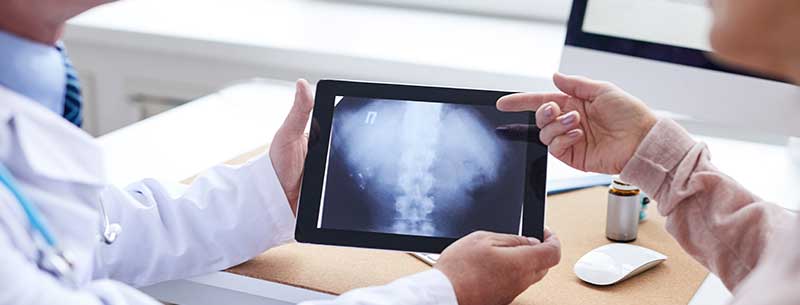Causes of Disc Diseases

A disc may herniate or rupture once any part of the center nucleus pulposus begins pushing through the outer edge of the disc and back toward the spinal canal. Often if the bulge is too large, it may lead to a more serious condition called spinal stenosis. Any of these conditions puts pressure on the nerves, pressure on the nerve will equate to pain. Pain, is a great diagnostic tool when examining a potential patient with a bulge or herniation. Usually the pain is deeper.
Spinal nerves may often be sensitive to even slight amounts of pressure, which can result in pain, numbness, or weakness in one or both of the arms or legs. MRI’s are standard protocol for decompression patients, prior to treatment, to quantify and qualify the extent of the lesion.
Bulging discs, disc herniation, and disc ruptures are the most diagnosed by MRI studies. The diagnosis of bulging disc or herniation is not uncommon with back pain or sciatica. Through true non-surgical spinal decompression, you can isolate the specific segment, once this is done, you will program your machine to pull at a specific angle.

There are four basic classifications that exist to describe disc lesions:
- Disc or annular bulge
- Protrusion (herniation)
- Extrusion
- Free disc fragment (sequestration)
The goal of our team at Total Health is to make an accurate diagnosis of the condition. The quicker the diagnosis usually the better outcome, as a bulge or a herniation left untreated will get worse over time. Here time is our ally and our enemy.
After being a doctor and reviewing research for many years I have come to learn no two patients are the same. Each person individuals’ symptoms of kinesiopathology, disc degeneration, and their relief from treatments, can vary tremendously. We have found no two patients feel or react to their problem the same, thus treatment programs must me tailor made for each patient. Once we get Mother Nature working, by reducing intra-discal pressure, as decompression technology, creates negative pressure to the disc environment, we facilitate the event we call decompression. This is the essence of decompression therapy.
There are many terms used to disc pathology and rather than try to reconcile each and every terminology used to refer to spinal anatomy or conditions, it's generally more useful for patients to gain a clear understanding of the precise medical diagnosis, this is where your MRI and associated diagnostic and consultations become very helpful.
Some examples of terms used to describe spinal disc abnormalities include:
- Pinched nerve
- Sciatica
- Herniated disc (or herniated disk)
- Bulging disc
- Ruptured disc
- Torn disc (or disc tear)
- Slipped disc
- Collapsed disc
- Disc protrusion
- Disc degeneration
- Degenerative disc disease
- Disc disease
Disc Centers of America, the network that Total Health has joined, works with disc cases all over the world. Only DCOA doctors are certified to utilize TDC Therapy. DCOA doctors receive ongoing training, research and are acknowledged by the International Medical Advisory Board on Non-Surgical Spinal Decompression and the International Disc Education Association.
Our office goal (with two convenient locations in Northern New Jersey: Florham Park, NJ and Berkeley Heights, NJ) is to tailor a specific program to your needs. We need a recent MRI (which we can order for you) and we can then decide if you are a candidate for our specific treatment including decompression therapy, deep tissue laser, proper core exercises, hip mobility exercises, back brace to keep you stable as you heal, review of proper mechanics to save your spine and chiropractic manipulation.
Call today to see if you are a candidate. We are always willing to sit with you for a consultation at no cost and review your case and answer all your questions. Call us at 908-665-0770 or email us at info@totalhealthnj.com to set up an appointment today!
SCHEDULE A CONSULTATION

